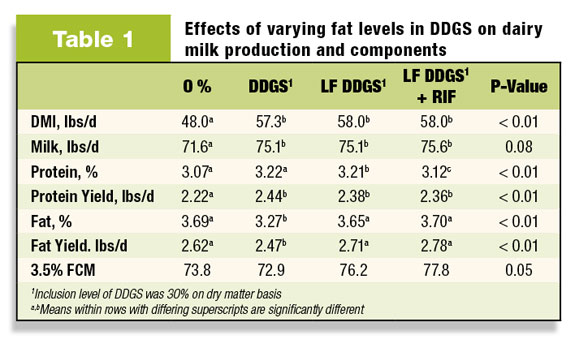Recent movement in the ethanol industry to extract some of the oil from the co-product distillers dried grains with solubles (DDGS) has grabbed the attention of the livestock feeding sector. With change comes opportunity and the dairy industry is poised to capitalize.
In the past, lactating dairy cows have typically been fed two to five pounds of DDGS per day. Dairy producers and nutritionists have not felt comfortable with high inclusion levels, primarily because high levels of polyunsaturated fats have led to milk fat depression.
This type of fat is commonly produced by oil-producing seeds such as soybean meal, whole cottonseed and corn. When multiple sources of fat from oil seeds are fed, the result is a greater risk for milk fat depression in the milking parlor.
Thus, a DDGS with a lower crude fat content can be beneficial, allowing higher inclusion levels of an economical feed ingredient to be fed to dairy cows in lactation.
Why is corn oil being extracted from DDGS?
In the beginning, the ethanol industry produced three products: ethanol, DDGS and carbon dioxide. As the industry has matured, so has the range of products and revenue streams.
One of these new product lines is corn oil, extracted pre-fermentation or post-fermentation. With dry grind ethanol production, the vast majority of this is post-fermentation.
The thin stillage stream left after distillation is further processed into corn condensed distillers solubles. This is where fat removal occurs through the use of centrifuge technology.
Regardless where or how the oil is removed, the result is a DDGS product with lower crude fat levels but slightly higher protein and fiber levels.
Currently, it is estimated upwards of half the ethanol industry extracts some oil from the product, with the expectation this will grow to the majority of the ethanol plants by the end of 2012.
Thus, it is becoming increasingly necessary to rethink how DDGS should be fed to dairy cows. Sourcing DDGS that will have a consistent level of crude fat is going to be challenging for producers. Producers and nutritionist will have to re-evaluate not only the source of DDGS but also if DDGS as an ingredient is a fit for their ration.
Nutritional aspects of de-oiled DDGS
Nutritional variability is an important factor in formulating rations and the increase in oil extraction adds another element to that. Variability depends on factors including equipment, technology, technique and working knowledge of personnel.
It is important for dairy livestock producers to have a consistent source of DDGS from a supplier that is able to produce consistent crude fat levels along with other key nutrients. As the ethanol industry continues to create new ethanol co-products, such as corn oil, it becomes more imperative for dairy producers to work with a supplier that provides an identity-preserved product.
Dairy research
There is a growing body of research that supports use of feeding higher levels of DDGS containing crude fat levels of 4 percent to 6 percent. We recently sponsored a trial conducted by the University of Nebraska (see Table 1) to test four DDGS ration inclusion levels:
- Control, no DDGS
- DDGS 11 percent fat
- DDGS 5.5 percent fat
- DDGS 5.5 percent fat plus bypass fat
DDGS inclusion levels were held constant across all treatments at 30 percent.
Positive results with DDGS 5.5 percent fat showed no milk fat depression occurring, while milk production increased significantly over the control.
However, DDGS 11 percent fat treatment showed a significant milk fat depression, which is indicative of what happens when high levels of DDGS are fed.
Lastly, DDGS 5.5 percent fat plus bypass fat treatment showed positive performance results for milk components and production as well. These results parallel results from several other studies.
Summary
The DDGS many dairy producers have been effectively feeding for the past several years will become harder to find. Corn oil extraction appears to be well on the way to being the norm in the ethanol industry, so it would be in the best interest of dairy livestock producers to learn how the resultant co-products fit in their operations.
Managing variability will continue to be a challenge. Knowing the source and quality behind the DDGS cannot be overemphasized. PD
Kip Karges is theTechnical Services and Research Director withPOET Nutrition.





